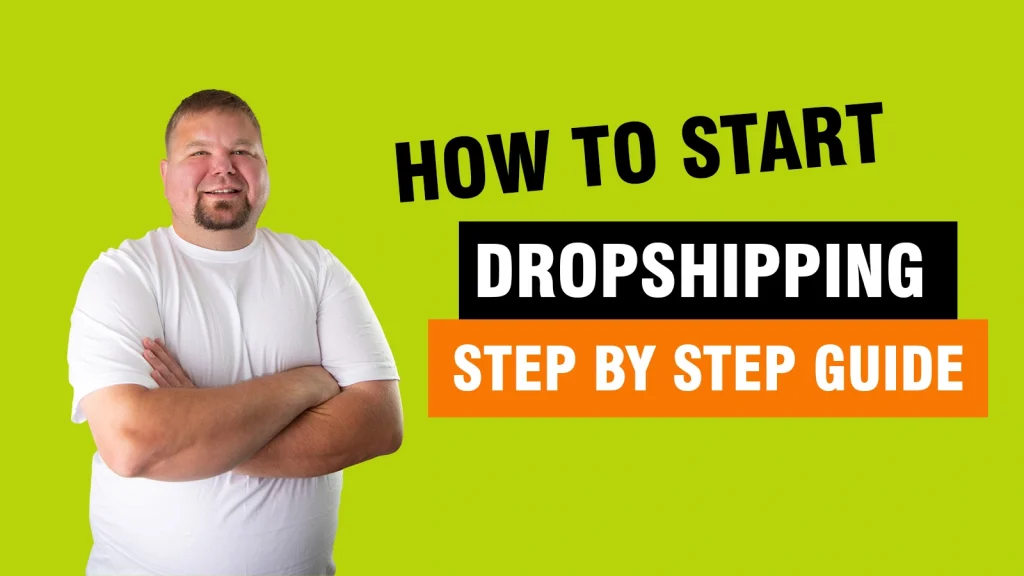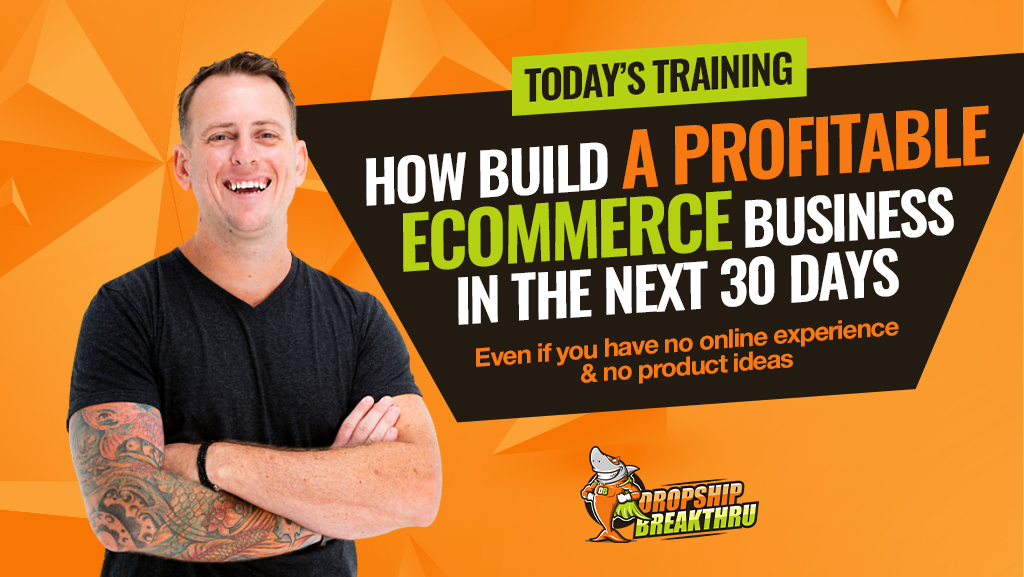How to Start Dropshipping: A Step-by-Step Guide to Building a Profitable Business

Want to know how to start dropshipping?
First, let’s answer the question, “What is dropshipping?”
Dropshipping is an Ecommerce business model where you don’t have to keep inventory on hand. Instead, when a customer makes a purchase from your online store, you buy the product from a third-party supplier, who then ships it directly to the customer.
This means you don’t have to worry about storing, packing, or shipping products. This makes dropshipping a low-risk, cost-effective way to start an Ecommerce business without all the hassles of other models.
How can a beginner start dropshipping? Your first step is to educate yourself about the business model, research market trends, and identify profitable niches. Once you have a solid understanding of those things, you can begin setting up your online store, selecting reliable suppliers, and marketing your business to attract customers. I’ll talk you through all these steps (and more!) in this post.
Let’s get started.
Step 1. Get in the Right Mindset
Your first step is to make sure you’re in the right mindset and fully committed to building your business. Here’s how to gear up and get prepared:
- Set realistic goals: Define clear and achievable goals for your dropshipping business. Understand before you start that success won’t happen overnight, and be prepared to do the work. Set small, achievable goals and know that growth might be slow at first — but don’t quit!
- Invest time and money wisely: Starting a dropshipping business requires both time and financial investment. Research the market, educate yourself about the industry, and be prepared to spend money on essentials like setting up your dropshipping store and marketing in your niche.
- Take a customer-centric approach from day one: Remember that dropshipping isn’t just about putting a bunch of products on your website and crossing your fingers that sales come in. To succeed in high ticket dropshipping, you have to serve your customers first and foremost. Always be thinking about your customers. Your store, product descriptions, shopping experience, and customer service will all focus on that real person behind the screen.
Let’s get one financial investment question out of the way. One common question aspiring entrepreneurs ask is, “Can I start dropshipping with $100?” It’s possible to get a few foundational pieces for just a hundred bucks, but we recommend starting with a budget of around $500 to cover essential costs like purchasing a domain name, setting up your store, and investing in initial marketing efforts.
Step 2. Identify Your High Ticket Niche
Once you’ve got your mindset in order, focus on choosing a high ticket dropshipping niche.
Again, your niche isn’t just about the products — it’s about your customers. Focus on finding a person with an existing passion, then find the products that person uses.
Keep your eye out for possible niches in your daily life. What kinds of products are you using? What niches have snagged the interest of friends, family, and community members? What trends are you seeing online? Once you’ve got a list of potential niches, evaluate them using these criteria:
- People like it: Go for niches that people are passionate about. Products in these niches aren’t usually necessities, but they are things people are interested in and excited about investing in.
- The price is right: Aim for products that sell for $1000 or more. That’s your high ticket dropshipping niche.
- Lots of suppliers: Make sure there are plenty of suppliers in your home country to choose from in this niche.
- Some competition: Look for niches with a bit of competition, but not too much. You want enough competitors that it’s clear you’re tapping into existing demand, but not so many that you’ll disappear in a packed marketplace.
- The ability to keep people coming back: Find niches where customers buy from you again and again.
- High search data: Check if people are searching for your niche online. If no one’s looking for your idea, it’s not a good pick.
- You like it: Make sure you actually like the niche you’re going into. It doesn’t have to be your reason for living, but don’t pick something that bores you. This will make life easier when the going gets tough in your business.
If your niche checks all the boxes, go ahead and start your business. If you end up with multiple ideas that fit the bill, start with one and save the rest for later.
Want help with niche selection? Try our free training, where you’ll learn how to build and launch a dropshipping business in 30 days!
Step 3. Research Your Competition
Identifying and scoping out your competition is the secret to understanding your market and positioning your dropshipping business. Here’s how to do it:
- Google Search: Start by conducting a simple Google search using relevant keywords related to your niche. Pay attention to the top-ranking websites and analyze their offerings, pricing, and customer reviews.
- Google Shopping: Use Google Shopping to compare product prices and features offered by different sellers within your niche.
- Social media: Explore social media platforms like Facebook, Instagram, and X to see how your competitors engage with their audience and promote their products. Make notes about their content, engagement levels, and follower demographics. You can check out their ads, too, but remember that I don’t recommend using social media ads to market your dropshipping store.
- Marketplace platforms: Visit online marketplace platforms like Amazon and eBay to see which competitors are selling similar products and how they present their listings.
- SEO Tools: Use Google Trends or another platform of your choice to analyze your competitors’ search engine visibility. Figure out their keyword strategies, look at their backlink profiles, and check their domain authority. This data will help you find content gaps and optimize your SEO approach.
Market research like this will give you valuable insight into trends, customer needs and preferences, and pricing strategies, so you can stand out in your niche.
Step 4. Partner with Reliable High Ticket Suppliers
When it comes to high ticket dropshipping, partnering with the right suppliers can make or break your business. You need reliable partners who consistently deliver and ship top-notch products quickly.
So where do you find these all-star suppliers? Start by seeking out well-established brands that people know and trust. Household names come with built-in credibility.
While investigating brands, look for sections of their sites dedicated to “becoming a seller” or “becoming a dealer.”
One of the best places to find dropshipping suppliers in your niche is through simple Google searches. The search engine results pages (as well as Google Shopping results) are a goldmine of information that can connect you with suppliers.
Step 5. Choose the Right Ecommerce Platform for High Ticket Items
Once you’ve found your niche and chosen your suppliers, it’s time to set up your store. During this step, remember that not all Ecommerce platforms are created equal. You need a platform that will give you the tools and flexibility to sell high ticket products. The only Ecommerce platform that we recommend for dropshippers is Shopify.
Shopify is the ultimate powerhouse for high ticket dropshipping. It gives you all the necessary features to showcase your high-end products and deliver a great customer experience. You can customize your store how you want and make it SEO-friendly.
To get started with Shopify, sign up for a free trial, then it’s just $29 a month.
Here’s a bonus: When you enroll in our dropshipping course, you’ll get our favorite Shopify theme, Superstore, at no extra cost. We’ll also give you the training to modify Superstore so you can rank higher in the search engines. I’ll cover SEO in more detail in a bit.
Long story short: Don’t settle for some rinky-dink Ecommerce platform that can’t handle the heat. Learn how to dropship on Shopify to give your high ticket dropshipping business a solid foundation.
Want more in-depth knowledge about Shopify (and why we love it so much)? Check out our free training to learn how to use this platform to start your dropshipping business in just 30 days!
Watch the Video:
Step 6. Design a Premium Online Store
Got Shopify and an attractive, easy-to-navigate theme? Great! Now it’s time to create an online store that reflects your offerings.
Use high-quality product images and detailed, persuasive descriptions highlighting each item’s unique features. Don’t just list specs; help customers envision how your products will improve their lives.
Use original photos and descriptions rather than copying and pasting manufacturer-provided content. This will help your brand stand out from competitors.
Your online store is your virtual showroom, so create a positive online experience for your customers that justifies the premium prices of your high ticket items.
Step 7. Price Your High Ticket Products
Now let’s talk numbers. When pricing your high ticket items, you have to strike a balance between profitability and competitiveness.
So how do you find that sweet spot? First, do your homework. Scope out the competition and see what they’re charging for similar products. This will give you a baseline to work from. But don’t just blindly match their prices. Factor in your own costs and the profit margins you’re going for.
Don’t just go for the lowest possible prices. That will wreck your profit margins, and besides that, you must follow Minimum Advertised Pricing (MAP) rules. If you’re reselling branded products, you need to play by their pricing guidelines. Under MAP, each reseller must comply with the minimum advertised pricing rule, which means they can’t advertise the brand’s products below a certain threshold.
This might seem like a hindrance at first, but it’s a good thing. MAP helps maintain brand integrity and prevents cut-throat price wars that can devalue your products in the long run.
Step 8. Decide on Your Business Structure
Structuring your business doesn’t need to be complicated.
When you’re starting, a sole proprietorship is totally fine. It’s quick, easy, and keeps things simple.
As your business grows, you may want to consider forming an LLC. It offers some extra legal protection and tax benefits. Most high ticket dropshippers eventually go the LLC route, but there’s no rush. Just something to keep in mind as your business expands.
Step 9. Establish a Solid Financial Footing
When running a high ticket dropshipping biz, keeping your finances organized and tracking your spending and earnings is crucial.
Open up a separate bank account for your dropshipping endeavors. This will help you keep track of your income and expenses without any personal stuff muddying the waters. Also consider credit card rewards and how you can benefit from them.
Most importantly, stay up to date on your bookkeeping from month to month (it’s a lot easier to take care of bookkeeping a little bit at a time rather than waiting until tax time to do it all). When you keep your finances organized and clear, your future self (and your accountant) will thank you.
Step 10. Use These Marketing Strategies for High Ticket Dropshipping
Want to know how to market your dropshipping store?
First, let’s talk about what not to do: Rely on social media ads. While platforms like Facebook and Instagram can be a decent tool for building brand awareness, they’re not an effective way to drive sales for high-priced products. People simply aren’t in the buying mindset when they’re scrolling through their social feeds. So cross social media ads off your dropshipping marketing list.
Instead, focus your efforts on capturing demand through the search engines. When people are actively searching for the products you offer, they’re much more likely to make a purchase. This is where Google Ads and SEO come into play.
With Google Ads, you pay to place your products front and center when people search for relevant keywords. It’s a fast way to start generating sales, but it can get pricey. To maximize your ROI, be strategic with your targeting and use negative keywords to avoid wasted clicks.
But the real long-term winner? SEO. Hands down, dropshipping SEO is the most important marketing strategy for your business. By optimizing your site to rank higher in search results, you can tap into a massive pool of organic traffic, and these visitors are actively looking for what you’re selling.
SEO takes time and effort to get rolling, but it’s an investment that really pays off. It’s worth investing some time and energy to improve your rankings and capitalize on that free traffic.
Of course, don’t neglect the power of word-of-mouth. Provide exceptional customer service, genuinely engage with your audience, and create unique, compelling product descriptions. These small touches can make a big difference in getting people talking about your store.
Step 11. Manage Customer Service and Returns
Exceptional customer service is non-negotiable in high ticket dropshipping. Make sure you’re responsive and attentive to customer inquiries.
Get yourself a direct phone number for customer support, and answer the phone when it rings (this sounds basic, but you’d be surprised at how many dropshippers don’t answer their phone!). Reply to emails within 24 hours, and always maintain a friendly, professional tone.
Have a clear, fair return policy in place and communicate it upfront. Dropshipping returns are an inevitable part of doing business, so be prepared to handle them graciously and promptly. With every return, your goal is to turn a potentially negative experience into a positive one.
Remember, happy customers are the lifeblood of your business. Treat them well, and they’ll repay you with loyalty and glowing reviews.
Step 12. Commit to Continuous Learning
Staying stagnant isn’t an option if you want to become a successful dropshipper. The dropshipping world is constantly evolving with new trends, technologies, and best practices. To stay ahead of the curve, be proactive about staying informed and updating your strategies.
Investing in your education is one of the best ways to do this. Take courses, attend workshops, and seek out mentorship from successful dropshippers. Surround yourself with a network of like-minded entrepreneurs who can offer support, advice, and fresh perspectives.
We’ve got an incredible community of dropshippers you can tap into when you join our dropshipping course — and you also get access to Jon and me during Q&A sessions.
But learning is only half the battle. You also need to be willing to put that knowledge into action. Don’t be afraid to experiment with new tactics, test out different approaches, and pivot when you need to. The most successful dropshippers are the ones who stay agile and adapt to changes in the market. They’re constantly looking for new opportunities and aren’t afraid to take calculated risks.
Building a successful dropshipping business is not a “set it and forget it” deal. You’ll need to commit to evolving, learning, and growing as you hustle.
What to Avoid When Starting a Dropshipping Business
There are a few common dropshipping mistakes to watch out for:
- Don’t run social media ads. They’re not an effective way to sell high ticket products.
- Don’t blow your budget on top-of-funnel SEO terms in your Google Ads. Focus on keywords with high purchase intent.
- Avoid selling products in the “no man’s land” price range ($300-$800). Go for true high ticket items to maximize your margins.
- Don’t get so caught up in pushing products that you forget about the person behind the screen. Focus on serving your customer, not just making a sale.
- Don’t neglect your website’s user experience. A clunky, confusing, or slow-loading site will drive potential customers away. Invest in a clean, professional platform and theme that is easy to navigate.
- Don’t skimp on customer service. If you don’t prioritize customer support, it can lead to negative reviews, lost sales, and a damaged reputation. Have systems in place to handle inquiries, issues, and returns promptly and professionally.
- Don’t try to be everything to everyone. Focusing on too many niches or products can spread your resources thin and make it difficult to establish yourself as an authority. Stick to a targeted niche and curate a selection of high-quality, complementary products.
Keep these common pitfalls in mind as you launch your high ticket dropshipping business, and you’ll be well on your way to building a solid long-term business.
How to Get Into Dropshipping: The Perfect Next Step
So that’s the lowdown on how to start a dropshipping business. If you’re fed up with the 9-to-5 grind, tired of being in debt, or just itching to be your own boss, dropshipping might be the perfect fit for you.
Jon and I have set up multiple successful dropshipping businesses, and now we’re here to help you do the same. Fair warning: It’s no cakewalk, and dropshipping is not a get-rich-quick scheme. But setting up a dropshipping business is absolutely worth it. If you’re ready to put in the work, you can build a profitable dropshipping business that flips the script on your entire life.
Ready to get started? Sign up for our free, on-demand training and learn how to launch your own high ticket dropshipping business in just 30 days.

Want to start your own high ticket dropshipping business?
Watch this FREE, on-demand training session that will uncover the exact steps you need to take to launch your first high ticket dropshipping business in the next 30 days.

Article by Ben Knegendorf
Ben Knegendorf realized at 29 he needed to find another career path. Since then, he’s:
- Successfully exited a high-ticket drop shipping business that he helped take from $1 to $11M annual revenue in just 2.5 years
- Eliminated $40,000+ of personal debt
- Joined Dropship Breakthru as co-owner in 2021
Ready To Start Your Own High Ticket Dropshipping Business?
Book your complimentary call with one of our high ticket dropshipping experts who are also successfully running a business right now and are Dropship Breakthru members, to learn more about getting started.
© Dropship Breakthru LLC 2024

